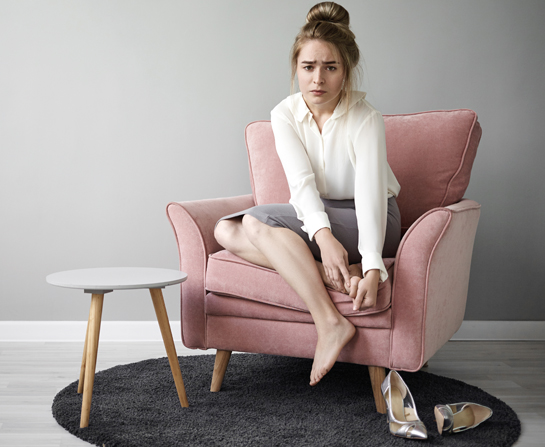The Truth about Bunions
April 29, 2022 Return

WORDS HANNAH MAY-LEE WONG
Lim Yuanshuang Podiatrist |
Having bunions on their feet is a common problem amongst women, and it’s a particularly frustrating foot condition to have too—just think of all those beautiful high- heeled shoes that feet with bunion can’t fit into. Some of us may turn to bunion correctors, toe separators or opt to wear slippers all the time in attempt to reverse the bunion, but do these things really help? We talk to a podiatrist to find out.
WHAT IS A BUNION?
The medical term for bunions is hallux valgus. It is a bony bump that forms on the metatarsophalangeal joint, at the base of the big toe. It develops over time and gets worse as the big toe is gradually pushed further towards the next toe (the second toe). The severity and symptoms of each person’s bunion may vary. Some bunions may look severe, but the person doesn’t have any pain; some bunions may be small but red, swollen and painful. Smaller bunions called bunionettes can also develop on the joint of the little toe.
DO BUNIONS HURT?
Some bunions can be painful, especially in those who have arthritis. It can also hurt if the skin or joint of the big toe has been rubbing on the shoe while walking, if a person has bone spurs or if a person suffers calcifications in the bones.
WHY DO PEOPLE GET BUNIONS?
The exact cause of bunions is unknown, but it is known family history plays a very big role. Some people are born with it; There are people who don’t wear narrow or ill-fitting shoes, yet they still get very bad bunions— in these cases, it’s most likely hereditary. People with arthritis also tend to develop bunions.
Some people develop bunions over time. It’s especially common among ladies who like to wear high heels. This is because when you walk in V-shaped (sharp ended) shoes like high heels, all the weight and pressure from your body is directed towards the second toe, so your big toe tends to sway towards the second toe. Due to friction and the uneven distribution of pressure when walking, people with bunions also tend to get calluses under their bunions
People who enjoy activities such as rock-climbing, where participants tend to wear very tight shoes and use mainly their toes to do all the exercise, are prone to developing bunions. Over time, people who do rock- climbing will develop bunions too, so bunions don’t only happen in ladies.
“The gold standard shoe for people with bunions would be sport shoes, because these have lots of cushioning and support”
IS IT ADVISABLE FOR PEOPLE WITH BUNIONS TO WEAR OPEN-TOE SHOES MORE OFTEN?
Not really. The gold standard shoe for people with bunions would be sport shoes, because these have lots of cushioning and support, especially on the heel. You should pick shoes that control and limit heel movement.
The most important factor for choosing the right shoes is the toe-box width—it should be wide enough for your foot. Also, the bending of the shoe should not be too flexible, get something that only bends at the toes. That said, each patient is suited to different types of shoes. The older patients would need shoes that are more flexible because they already have very rigid joints. Whereas for younger patients who are very active, shoes that are too flexible might promote wobbling and worsen the problem, so I would recommend more supportive and rigid shoes.
WHAT SHOES WOULD YOU RECOMMEND FOR LADIES WHO MAY NOT WANT TO WEAR SPORTS SHOES ALL THE TIME?
I would recommend covered shoes that are: flat, have heel support, have limited flexibility but bends at the toes and most importantly, shoes that have a wide toe-box.
HOW ARE BUNIONS TREATED?
It is important to note that bunions can be managed but they can’t be reversed. The only way to reverse a bunion is through surgery, done by an orthopaedic surgeon.
Podiatrists can give conservative treatments like teaching patients how to choose the right shoes. If they have pain, we look for ways to reduce the pain. Most of the time, podiatrists will prescribe orthotics—they look like insoles, but there are modifications being made according to each person’s needs. Examples of modifications include: heels extensions (to limit heel mobility and helps make the shoe more rigid), extensions in the front (to push the out-toeing inwards) and some extra padding at the front for support.
For a painful bunion, podiatrists may prescribe orthotics with hard extensions at the side to limit the flexibility of the bunion—this is done so that the bunion does not turn on the joint too much and the pain will be reduced.
DO BUNION CORRECTORS WORK?
Bunion correctors that you see in the market might help with pain, but these don’t lessen the severity of the bunion.
WHAT CAN WE DO TO PREVENT BUNIONS FROM GETTING WORSE?
The best way is to wear the right shoes. Nowadays, there are shoes that are constructed with Lycra® material at the side of the shoes, for the bunion to sit on. Lycra® is a soft stretchy material, so having this material at the sides ensures your bunion doesn’t rub too much on the shoe. Some shoes have the soft material covering the whole toe box, and these are also good for people suffering hammer-toe or stiffness of joints. Unfortunately, these shoes don’t look the prettiest, so it may not be for everyone.
A tip for picking out shoes: Put your foot on top of a shoe that is of your size and see whether your foot is bigger than the shoe, especially in terms of width. If your foot covers the shoe, it’s too narrow for you. HT
“The only way to reverse a bunion is through surgery, done by an orthopaedic surgeon. ”
If you like this article, do subscribe here.

